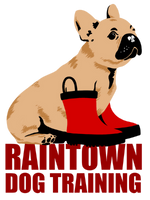Off-Leash Tips, Dog Park Safety and Dog Friendly Spaces
Tip 1: Dog Park Safety
Letting your dog off leash can be a big leap of faith - we’ve all heard or read scary stories about dog park mishaps! Below are two important factors to keep in mind for your pup’s safety when enjoying off-leash public spaces.
Body Language
How can we tell if our dogs are having a good time? Look at the dog to dog body language. Look for a loose, wiggly, ‘noodle’ body! Bouncy, exaggerated movements and loose, floppy bodies signal to us that a dog is relaxed and enjoying play. A stiff body, on the other hand, is a sign that a pup is feeling stressed or nervous. If your dog is showing a stiff body, tucked tail, or avoidance behaviors, it may be time to exit the park and work on building confidence in a calmer setting.
Recall
Asking our dogs to come away from something very exciting (other dogs) and back to us is a difficult task. For this reason, recall should first be trained in your home where it is least distracting, using high value treats. As your pup’s recall becomes more reliable, try bringing it to more and more distracting environments - a quiet park, then a busy park, and then the dog park. If you are nervous about your dog running off, a fully-fenced park may be best to start with.
Tip 2: Dog-Friendly Spaces
Now your dog is ready to venture into the world of off-leash… but where will you take them? Finding an off-leash designated park is important in order to keep on-leash public spaces accessible for dogs who may be fearful, reactive, or in training.
There is a lot of variation when it comes to dog parks and, as our Raintown team member Sara says, ‘Not all dog parks are made equal’. What you are looking for will depend on your pup’s needs and your own comfort level. In general, I would recommend choosing a park with plenty of space to prevent dogs from feeling confined or crowded. The app GoDoggo is an excellent tool for finding dog-friendly spaces in Vancouver - you can even use filters such as ‘fully fenced’ to refine your search!
Need some extra support to practice off-leash skills? Talk to a trainer!
Thought Of The Month
Off-leash play time is an important part of caring for social dogs. Many unwanted behaviors, including leash pulling, lunging, and barking, can be improved by giving your dog a few dog park outings each week!
For dogs who don’t love the company of other dogs, giving them time to sniff and explore outdoors is still extremely beneficial. A long line (longer leash) is a great option for giving dogs more freedom if you are unable to let them off leash.



